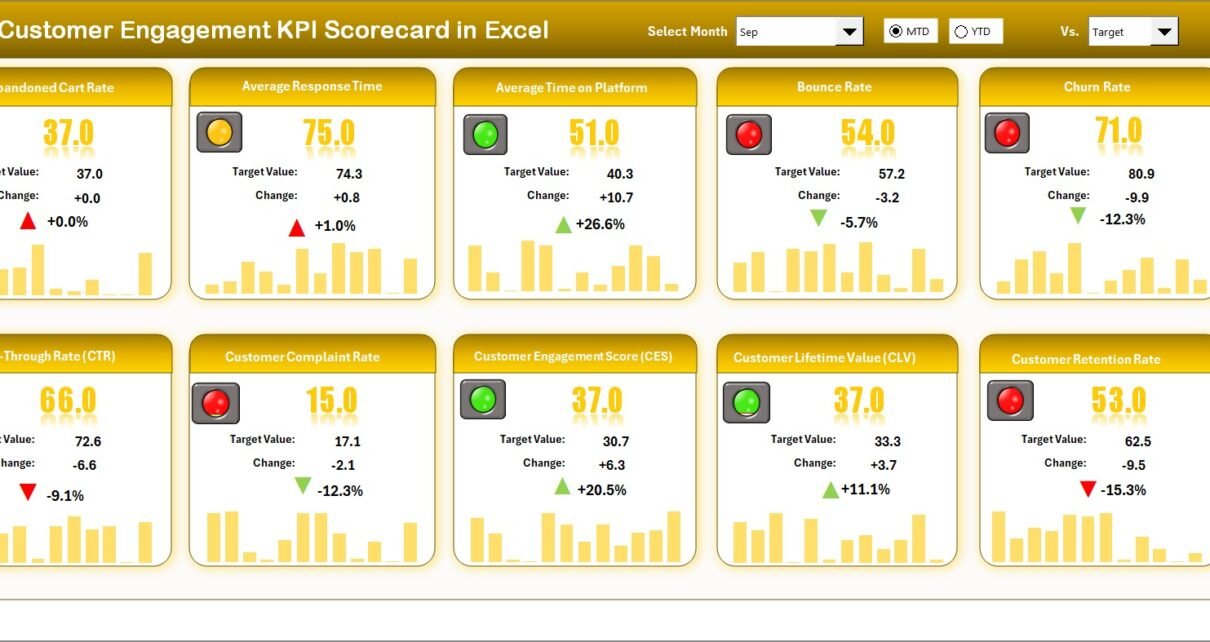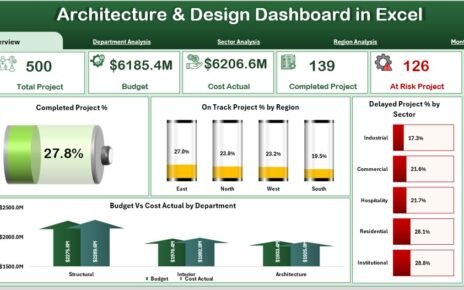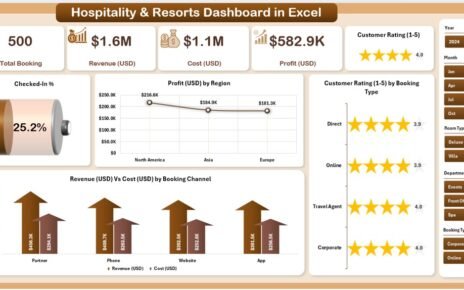In the modern digital era, cybersecurity is not just an IT issue — it’s a business priority. Every organization, from small startups to large enterprises, must continuously monitor how well their employees understand and follow cybersecurity practices. That’s where the Cybersecurity Awareness KPI Scorecard in Excel becomes a powerful tool.
This ready-to-use Excel template helps you track, analyze, and improve cybersecurity awareness across your organization with measurable insights. It bridges the gap between training programs and real-world performance by turning cybersecurity data into clear, actionable metrics.
Click to Purchases Cybersecurity Awareness KPI Scorecard in Excel
What Is a Cybersecurity Awareness KPI Scorecard?
A Cybersecurity Awareness KPI Scorecard is an analytical dashboard designed to measure the effectiveness of an organization’s cybersecurity awareness initiatives. It tracks Key Performance Indicators (KPIs) that reflect employee participation, knowledge levels, and compliance with cybersecurity best practices.
By using this scorecard in Excel, organizations can:
-
Monitor awareness training progress over time.
-
Identify areas where employees may lack knowledge.
-
Evaluate the overall impact of cybersecurity programs.
-
Make data-driven decisions to improve organizational resilience.
In short, it translates cybersecurity awareness into measurable results.
Key Features of the Cybersecurity Awareness KPI Scorecard in Excel
The Cybersecurity Awareness KPI Scorecard in Excel consists of four main worksheets designed for clarity, flexibility, and deep analysis.
1. Scorecard Sheet

This is the central interface where all KPI performances come together. It provides an at-a-glance summary of cybersecurity awareness across the organization.
Key highlights:
-
✅ Dropdown Menus: Choose the reporting period — whether it’s Month-to-Date (MTD) or Year-to-Date (YTD) — for flexible analysis.
-
📊 Actual vs. Target Values: Compare actual performance against defined targets for each KPI.
-
🎨 Visual Indicators: Conditional formatting highlights performance levels using colors and icons for quick status checks.
-
🔍 Comprehensive KPI Overview: View essential metrics such as participation rate, phishing test success rate, and password compliance.
This sheet serves as a real-time performance dashboard, making it easy for managers to interpret results instantly.
Click to Purchases Cybersecurity Awareness KPI Scorecard in Excel
2. KPI Trend Sheet

The KPI Trend Sheet provides an in-depth view of each individual KPI.
Features include:
-
🔽 Dynamic Dropdown (C3): Select any KPI to view its detailed trend.
-
🧩 KPI Details: Displays the KPI Group, Unit, Type (Lower the Better or Upper the Better), Formula, and Definition.
-
📈 MTD & YTD Trend Charts: Analyze trends for Actual, Target, and Previous Year (PY) data to understand progress patterns.
This page transforms complex data into easy-to-read visual trends, enabling proactive decision-making.
3. Input Data Sheet

The Input Data Sheet acts as the foundation of your entire scorecard.
How it works:
-
✍️ Data Entry: Record monthly actuals, targets, and other KPI metrics.
-
🔄 Real-Time Updates: As new data is entered, all connected sheets refresh automatically.
-
⚙️ Customizable Fields: Adaptable columns let you include department, location, or project details.
With this flexibility, organizations can keep the data up-to-date and align cybersecurity goals with business objectives.
4. KPI Definition Sheet

This sheet defines every KPI in clear, simple terms.
You’ll find columns for:
-
KPI Name
-
KPI Group
-
Unit of Measurement
-
Formula
-
KPI Definition
This ensures consistency in reporting and helps new users understand what each KPI represents.
Click to Purchases Cybersecurity Awareness KPI Scorecard in Excel
Why Cybersecurity Awareness Matters
Cybersecurity awareness is one of the strongest lines of defense against cyberattacks. Even with advanced firewalls and software protections, human error remains the weakest link.
According to industry studies, over 80% of data breaches occur due to user negligence or lack of awareness.
A well-structured KPI Scorecard helps bridge this gap by:
-
Measuring participation in training sessions.
-
Tracking phishing simulation results.
-
Identifying departments with low compliance.
-
Encouraging behavioral change through data visibility.
By making awareness measurable, you empower employees to take responsibility for cybersecurity.
Advantages of Using a Cybersecurity Awareness KPI Scorecard in Excel
Implementing this Excel-based scorecard offers multiple benefits across operational, strategic, and cultural levels.
1. Centralized Performance Monitoring
All cybersecurity metrics are visible in one place, helping management track training effectiveness and compliance levels across departments.
2. Real-Time Insights
With dynamic Excel formulas and visual indicators, you can instantly identify whether performance is improving or declining.
3. Cost-Effective Solution
Unlike complex software, this Excel template requires no additional cost or setup. It’s fully customizable and user-friendly.
4. Employee Engagement
Visual dashboards and color-coded KPIs make progress visible to everyone, fostering a culture of responsibility and awareness.
5. Decision Support
Leaders can prioritize training investments, identify weak areas, and align cybersecurity goals with broader business objectives.
6. Easy Customization
You can adapt KPIs, modify formulas, and even add new indicators as your cybersecurity strategy evolves.
How to Use the Cybersecurity Awareness KPI Scorecard in Excel
Here’s a simple guide to help you use the template effectively:
-
Set Up KPI Definitions:
Start by entering all KPIs, formulas, and descriptions in the KPI Definition Sheet. -
Input Monthly Data:
Record each month’s actuals and targets in the Input Data Sheet. -
Analyze with the Scorecard:
Use the Scorecard Sheet to compare performance visually. -
View KPI Trends:
Check monthly and yearly progress for each KPI in the Trend Sheet. -
Update Regularly:
Refresh your data monthly to ensure continuous tracking and improvement.
By following these steps, your team can maintain a proactive approach to cybersecurity awareness.
Click to Purchases Cybersecurity Awareness KPI Scorecard in Excel
Best Practices for Managing a Cybersecurity Awareness KPI Scorecard
To get the most value out of your scorecard, follow these best practices:
🔁 Update Data Consistently: Maintain monthly updates to ensure accuracy.
📊 Set Realistic Targets: Establish achievable benchmarks to motivate employees.
🎯 Focus on Actionable Insights: Highlight KPIs that influence behavior, not vanity metrics.
👥 Encourage Team Ownership: Share results with departments to create healthy competition.
💡 Automate Where Possible: Use Excel formulas and pivot tables for automatic calculations.
🧠 Link to Training Programs: Align KPIs with specific training modules or awareness campaigns.
🔐 Protect Sensitive Data: Use Excel’s data protection features to secure information.
These practices ensure that your scorecard becomes a living tool for continuous improvement, not just a reporting document.
How the Scorecard Supports Decision-Making
Organizations can use insights from this KPI scorecard to drive smarter decisions:
-
Identify departments that need additional training.
-
Evaluate which awareness initiatives are most effective.
-
Measure improvement in security posture over time.
-
Justify budget allocation for cybersecurity programs.
-
Correlate awareness levels with incident reduction rates.
When integrated with management reviews, these insights strengthen your overall cybersecurity strategy.
Transforming Data into Actionable Intelligence
The real strength of this Excel scorecard lies in its ability to turn raw data into intelligence.
Through visual dashboards and KPI tracking, teams can see the direct impact of awareness efforts.
Over time, consistent use helps build a culture where every employee becomes a defender of digital assets.
This shift from reactive defense to proactive awareness is what truly differentiates resilient organizations.
Advantages of Building It in Excel
You might wonder why Excel is an ideal platform for this scorecard. Here’s why:
-
Universal Accessibility: Everyone has access to Excel, making it easy to share and collaborate.
-
Customization Freedom: You can tailor KPIs, formulas, and visuals without coding.
-
Integration: Connect Excel with other data sources, like HR or LMS systems.
-
Ease of Visualization: Use conditional formatting, charts, and slicers for interactive visuals.
-
Scalability: Whether you track 10 or 1000 employees, Excel adapts to your needs.
In short, Excel offers flexibility without the overhead of expensive software.
Common Challenges and How to Overcome Them
While using a KPI scorecard offers many benefits, some challenges may arise:
1. Inconsistent Data Entry
If users don’t update the Input Data Sheet regularly, insights lose relevance.
Solution: Assign clear ownership and set monthly update reminders.
2. Unclear KPI Definitions
Vague KPIs can cause confusion and incorrect reporting.
Solution: Use the KPI Definition Sheet to maintain clarity and standardization.
3. Overcomplicated Dashboards
Too many KPIs can clutter your scorecard.
Solution: Focus on 10–15 key metrics that truly impact awareness.
4. Lack of Management Engagement
Without leadership support, awareness initiatives may stall.
Solution: Present visual reports that highlight ROI and risk reduction.
By addressing these issues early, you ensure that the scorecard remains a practical tool rather than a static file.
Conclusion
The Cybersecurity Awareness KPI Scorecard in Excel empowers organizations to measure, monitor, and improve employee awareness effectively.
It translates abstract concepts like “security culture” into measurable KPIs — making progress visible, actionable, and rewarding.
From tracking training completion rates to visualizing phishing response times, this Excel tool brings accountability to cybersecurity awareness.
With consistent use, it can significantly reduce risk, strengthen defenses, and foster a culture of digital vigilance.
As cyber threats continue to evolve, your best protection lies in an aware and informed workforce — and this scorecard helps you achieve exactly that.
Click to Purchases Cybersecurity Awareness KPI Scorecard in Excel
Frequently Asked Questions (FAQ)
1. What is a Cybersecurity Awareness KPI Scorecard?
It’s a performance tracking tool that measures how effectively an organization promotes cybersecurity awareness among employees through specific KPIs.
2. Why should I use Excel for this scorecard?
Excel offers flexibility, ease of customization, and powerful analytical capabilities without requiring complex software or technical expertise.
3. How often should I update the scorecard?
Ideally, you should update it monthly for MTD tracking and quarterly for YTD analysis to maintain accurate insights.
4. What are the most important KPIs to include?
Training Completion Rate, Phishing Simulation Success Rate, and Password Policy Compliance are some of the key indicators for awareness effectiveness.
5. Can this scorecard integrate with other tools?
Yes. You can import data from HR systems, Learning Management Systems (LMS), or other databases directly into Excel.
6. Is this suitable for small businesses?
Absolutely. Small organizations can use this scorecard to monitor awareness levels without investing in costly cybersecurity platforms.
7. How can visual indicators help?
Color-coded visuals and charts quickly highlight where performance meets or falls short of targets, making management reviews more efficient.
8. What if some KPIs show poor performance?
Use low-performing KPIs as a signal to re-evaluate training content, communication strategies, or employee engagement approaches.
9. Can I customize the KPIs?
Yes, you can modify the KPI Definition Sheet to include additional or organization-specific metrics.
10. How does this scorecard improve cybersecurity culture?
By making progress visible and measurable, it encourages accountability, recognition, and ongoing learning — the core elements of a strong cybersecurity culture.
Click to Purchases Cybersecurity Awareness KPI Scorecard in Excel
Visit our YouTube channel to learn step-by-step video tutorials



